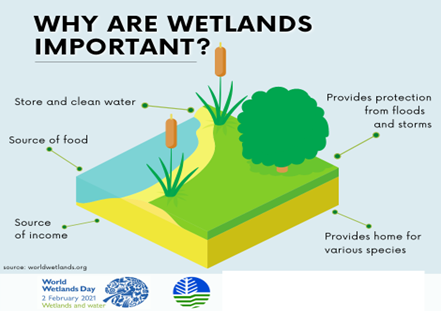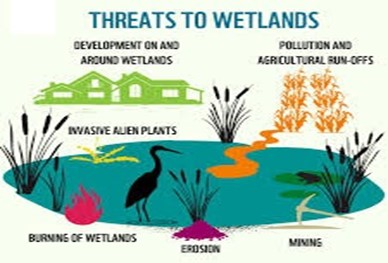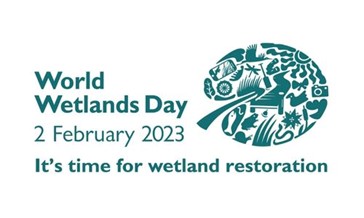PREVIOUS
Wetlands in India and Tamilnadu – Part II
May 19 , 2023
701 days
4845
0
(இதன் தமிழ் வடிவத்திற்கு இங்கே சொடுக்கவும்)
Importance of Wetlands
- Wetlands are particularly important providers of all water-related ecosystem services.
- Wetlands are productive areas for plant life, animals and wetland agriculture.
- Wetlands are the major habitat for most of the world’s waterbirds and key habitat for migratory species.
- Wetlands are an important source of food.
- Wetlands have high recreational, historical, scientific, and cultural values.
- Wetlands are amongst the most productive ecosystems and are often called the “biological supermarkets” as they produce a huge amount of food which attracts many animal species.
- It will Flood control act as natural sponges, helping in avoiding floods. They temporarily storing and gradually releasing stormwater.
- They help in improving water quality through removing or retaining inorganic nutrients or by processing organic wastes and reducing suspended nutrients.

- For this function, wetlands are often referred to as “Kidneys of the Earth”.
- They Help in carbon sequestration: they act as carbon sinks and wetland soil contains a high amount of carbon.
- They also provide the conditions needed for the removal of nitrogen and phosphorus from surface water.
- It will help in ecological conservation by hosting a large number of species of microbes, plants, insects, amphibians, reptiles, birds, fish, and mammals.
- It will Support various plants and animals having medicinal and commercial values.
- Many countries have their fishing and shell fishing industries dependent on wetlands.
- It acts as a source of livelihood for local people as many of them are dependent upon wetlands resources for their employment.
Wetland Degradation in India
- According to the estimates by Wetlands International South Asia, nearly 30% of the natural wetlands in India have been lost in the last three decades mainly to illegal construction, unsustainable urbanisation, agricultural expansion and pollution
- Mumbai has lost maximum wetlands (71%) from 1970 to 2014.
- Other major cities that faced wetland loss include Ahmedabad (57%), Bengaluru (56%), Hyderabad (55%), Delhi and National Capital Region (38%), and Pune (37%).
Threats to Wetlands
- Dense human population in catchment areas.
- Rapid urbanization.
- Drainage of wetlands for agricultural and construction activities causes harm to wetlands.
- The introduction of invasive species to wetlands damages the wetland ecosystems.
- Pollution of wetlands due to human activities such as the dumping of factory wastes is harming the flora and fauna of wetland ecosystems.
- Climate change is another major factor that acts as a threat to wetlands.
- The construction of dams alters the flow of water to wetlands thus altering the healthy status of wetlands.
- Weed choking is another cause of concern for wetlands.
- Sand and shell removal is harming the wetlands.
- Wastes from intensive aquaculture are another threat.
- Upstream human activities exert pressure on the downstream area in coastal backwaters.

Methods for restoring wetlands
- The 4 Basic Steps of a Wetland Restoration
- Step 1: Treatment of invasive species.
- Step 2: Placement of clean sand and sediment.
- Step 3: Seeding and planting.
- Step 4: Maintenance and monitoring.
Measures in India for Wetland Conservation
Ramsar Convention
- The Convention on Wetlands, also called the Ramsar Convention, is an international treaty calling for “the conservation and wise use of all wetlands through local and national actions and international cooperation, as a contribution towards achieving sustainable development throughout the world”.
- It was adopted at Ramsar, Iran in 1971 and came into force in 1975.
- The United Nations Educational, Scientific and Cultural Organisation (UNESCO) is the depository of the Convention.
- The Secretariat of Ramsar Convention is functioning within the headquarters of the International Union for the Conservation of Nature (IUCN) in Gland, Switzerland.
- On 21 August 2015, the Contracting Parties approved the Four Ramsar Strategic Plan for 2016-2024.
- The World Wetlands Day is celebrated on 2nd February every year.
- The Montreux Record is “a register of wetland sites on the List of Wetlands of International Importance where changes in ecological character have occurred, are occurring, or are likely to occur as a result of technological developments, pollution or other human interference”.
- It is maintained as part of the Ramsar List.
- Under the three pillars of the Convention, the contracting parties commit to
- 1) Work towards the wise use of all their wetlands.
- 2) Designate suitable wetlands for the list of Wetlands of International Importance (the “Ramsar List”) and ensure their effective management.
- 3) Cooperate internationally on transboundary wetlands, shared wetland systems and shared species.
National Wetland Conservation Programme (NWCP)
- It was launched in 1985 to enable conservation and wise use of wetlands in the country so as to prevent their further degradation.
The Central Wetlands (Conservation and Management) Rules
- They were notified for the first time in 2010 for better management and regulation of wetlands across the country.
- It saw the formation of Central Wetlands Regulatory Authority (CWRA) whose term ended on 31 March 2015 and it wasn’t reconstituted since then.
National Environment Policy 2006
- Recognising the importance of wetlands, it calls for developing a national inventory of such wetlands and implementing a wide spectrum of policies and plans for wetland conservation and their environmental impact assessment (EIA).
Capacity Building
- In order to increase the capacity of wetland managers, up gradation of the existing Wetland Research and Training Centre of Chilika Development Authority at Barkul, Odisha into the National Capacity Development Centre for Wetlands is under consideration.
- National Mission for Clean Ganga
- The National Mission for Clean Ganga in January 2021 formulated a toolkit for management of wetlands and water bodies in urban areas as well as studying the concerns of rapid urbanisation.
Amrit Dharohar Scheme
- This scheme was announced in the 2023-24 budget for a period of 3 years.
- The scheme, identifying the importance of the wetlands, aims to promote their optimal use.
- Under this scheme, the communities will be at the centre stage with regard to wetland protection.
- This scheme will focus on enhancing the biodiversity in the wetlands, preserving and increasing their carbon stock, building upon their eco-tourism potential, and enabling the local communities to optimally use the wetlands for employment generation.
MISHTI (Mangrove Initiative for Shoreline Habitats & Tangible Incomes)
- Mangrove Initiative for Shoreline Habitats & Tangible Incomes (MISHTI)) envisage to comprehensively explore the possible area for development of Mangroves covering approximately 540 Sq. Kms.
- It spreading across 11 States and 2 Union Territories during five years commencing FY 2023-24 onwards.
Measures in Tamilnadu for Wetland Conservation
Tamil Nadu Wetland Mission
- The Government of Tamil Nadu launched the Tamil Nadu Wetland Mission in August 2022.
- The Tamil Nadu Wetlands Mission will identify and map 100 wetlands in 5 years.
- It will create to restore the ecological balance with focus on livelihood options.
- It will focus and take ac¬tion on climate change adaptation and mitigation activities.
International Organization Partners
- The Ramsar Convention works closely with six organisations known as International Organization Partners (IOPs). These are:
- Birdlife International
- International Union for Conservation of Nature (IUCN)
- International Water Management Institute (IWMI)
- Wetlands International
- WWF
- International Wildfowl & Wetlands Trust (WWT)
- Convention on Biological Diversity (CBD)
- Convention to Combat Desertification (UNCCD)
- Convention on the Conservation of Migratory Species of Wild Animals
- Convention on Migratory Species (CMS)
- World Heritage Convention (WHC) and
- Convention on International Trade in Endangered Species (CITES).
- Project funding is done by various groups like multilateral development banks, bilateral donors, UN agencies such as UNEP, UNDP, Non-governmental organisations etc.
World Wetlands Day
- The World Wetlands Day is celebrated on 2nd February every year.
- It aims to raise global awareness about the vital role of wetlands for people and planet.
- This day also marks the date of the adoption of the Convention on Wetlands on 2 February 1971, in the Iranian city of Ramsar.
- 2023 year's theme is “It's Time for Wetlands Restoration,” which highlights the urgent need to prioritize wetland restoration.

Conclusion
- Wetlands provide important ecological and socio-economic services.
- Degradation limits their ability to provide these services.
- COP 9 of Ramsar proposes several solutions to reduce wetland destruction and promote wetland conservation for sustainable fisheries.
- Implementation of U.S. wetland conservation measures in conjunction with existing policy has improved management and monitoring of our nations wetlands.
-------------------------------------
Leave a Reply
Your Comment is awaiting moderation.


